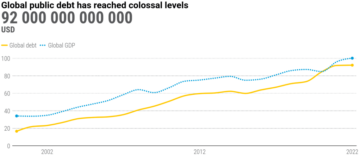HodlX Guest Post Submit Your Post
A company’s success is intricately linked to its marketing strategies in a highly competitive consumer market. The CMO Survey demonstrated that 72% of marketing chiefs felt that ‘the importance of marketing in their companies increased’ significantly in 2020-21.
It also highlighted that traditional advertising recorded a negative growth at -0.2% while digital ad spending increased by 17%.
The need for efficient marketing is thus evident. But the final word on the best marketing strategy is yet to come. Perhaps there will never be an answer carved in stone. Nevertheless, word-of-mouth (WoM) is a promising contender in this race one of the most effective marketing strategies, if not the most.
To put things in perspective, the Nielsen 2021 Trust in Advertising Study found that 88% of global respondents favor recommendations from friends and family over other forms of advertising. Corroborating Nielsen’s findings, 64% of marketing executives also consider WoM the most effective advertising form. On the flip side, though, only six percent of these executives have mastered WoM marketing enough to implement it effectively.
Some Web 3.0 protocols are, thus, innovating disruptive but practical WoM marketing solutions. This makes WoM more accessible for businesses, strengthening their marketing arsenal and return on investments (ROIs). Indeed, it’s as though WoM and Web 3.0 are made for each other.
The power of word-of-mouth marketing
Spreading information through word of mouth is perhaps as old as human civilization. Humans have a fundamental tendency to share their opinions and offer advice about the most impressionable things around them.
In addition, cultural practices like food, clothing and customs have often traveled from one region to another by word-of-mouth. This innate connection with human existence makes WoM such a powerful marketing strategy.
Scholars have formed multiple theories to understand WoM thoroughly. Some explanations attribute its success to empathy or altruism, while others refer to psychological dynamics of influence and control. Based on these understandings, market researchers have experimented to find the best possible combinations for optimizing marketing ROIs.
In one such study published in Harvard Business Review, the researchers discovered proper incentivization could encourage people to become efficient marketers.
However, existing Web 2.0-enabled WoM solutions have several critical disadvantages. In general, there’s a lack of transparency in value distribution among the participating stakeholders.
As a result, companies often don’t transfer the rewards to WoM promoters adequately and fairly, despite them doing the hard work of onboarding new customers through WoM. There’s also no effective mechanism for quantifying a marketer’s contribution to multiplying a company’s profits.
Having said that, the problem runs deeper than the quantification and distribution of rewards. In 2021, US advertisers lost $15.9 billion to digital advertising frauds by hackers and automated bots. It jeopardized consumers’ trust in following up on someone’s recommendations.
They have now become anxious about losing money to scams instead of receiving genuine feedback from WoM. Enter Web 3.0, where one needn’t necessarily ‘trust’ a company or project to get involved with it.
Web 3.0 word-of-mouth protocols arketing with a difference
Blockchain-powered Web 3.0 platforms have the potential to transform word-of-mouth marketing with rewards tokenization, immutable on-chain data preservation and enhanced asset provenance. The best part these protocols directly reward marketers for contributing to a company’s growth.
Users prefer Web 3.0 protocols over their Web 2.0 counterparts for multiple reasons. Trustless Web 3.0 ecosystems protect customers from fraud and hacks. Without an intermediary, marketers and consumers can directly share the benefits of adding value to the parent company.
Moreover, an on-chain ledger facilitates proper measurement of that marketer’s contribution while automating reward distributions.
As such, decentralization has significantly enhanced the rewards distribution process in Web 3.0. For example, in Web 3.0, when a marketer shares referral links through WoM, oracles can help trace and distribute rewards based on the true value added on the blockchain.
Suppose Bob purchases five NFTs or 100 crypto tokens using George’s referral link. Oracles can verify the purchase and proportionately distribute tokenized rewards in a trustless manner to both for a successful referral.
Moreover, unlike Web 2.0 platforms that offer static rewards, blockchain-based WoM protocols offer dynamic reward systems. Best known examples are staking and farming principles in DeFi. They incentivize early marketers and adopters with higher rewards than those who join late.
For token-based projects, marketers can also avail of premium rewards if they convince others to HODL. Such buy-and-hold incentive schemes can also encourage marketers to onboard long-term customers, promoting sustainable growth for the company.
Expanding the scope of dynamic incentives further, innovative protocols can offer novel revenue streams through referral farming with single and multi-referral tokens.
Moreover, the platform’s blockchain-agnostic nature enables cross-platform WoM marketing. Besides Web 3.0 native protocols, marketers can also spread the word on Web 3.0 platforms like the metaverse and social media like Twitter.
In sum, a company’s future depends on how well it leverages the three Es of marketing ngage, equip and empower. Web 3.0 word-of-mouth protocols have the ingredients for this mastery, ensuring better sales and customer retention.
In addition, proportionate rewards can ‘equip’ users to ‘engage’ with the Web 3.0 economy, ’empowering’ them to become an integral part of Web 3.0. This will usher in a robust advertising methodology and open up unexplored avenues of revenue generation.
Erwin Werring, CEO of Attrace, has experience across multiple industries including finance and entertainment. He has co-founded a gaming startup and a data and solution consolidation platform, that he sold to nine banks in 32 countries, before founding Attrace in 2018.
Follow Us on Twitter Facebook Telegram

Disclaimer: Opinions expressed at The Daily Hodl are not investment advice. Investors should do their due diligence before making any high-risk investments in Bitcoin, cryptocurrency or digital assets. Please be advised that your transfers and trades are at your own risk, and any loses you may incur are your responsibility. The Daily Hodl does not recommend the buying or selling of any cryptocurrencies or digital assets, nor is The Daily Hodl an investment advisor. Please note that The Daily Hodl participates in affiliate marketing.
Featured Image: Shutterstock/Oleg Nebesnyy
- Bitcoin
- blockchain
- blockchain compliance
- blockchain conference
- coinbase
- coingenius
- Consensus
- crypto conference
- crypto mining
- cryptocurrency
- decentralized
- DeFi
- Digital Assets
- ethereum
- HodlX
- machine learning
- non fungible token
- plato
- plato ai
- Plato Data Intelligence
- Platoblockchain
- PlatoData
- platogaming
- Polygon
- proof of stake
- The Daily Hodl
- W3
- zephyrnet












